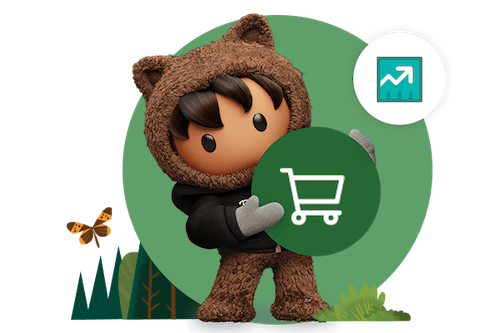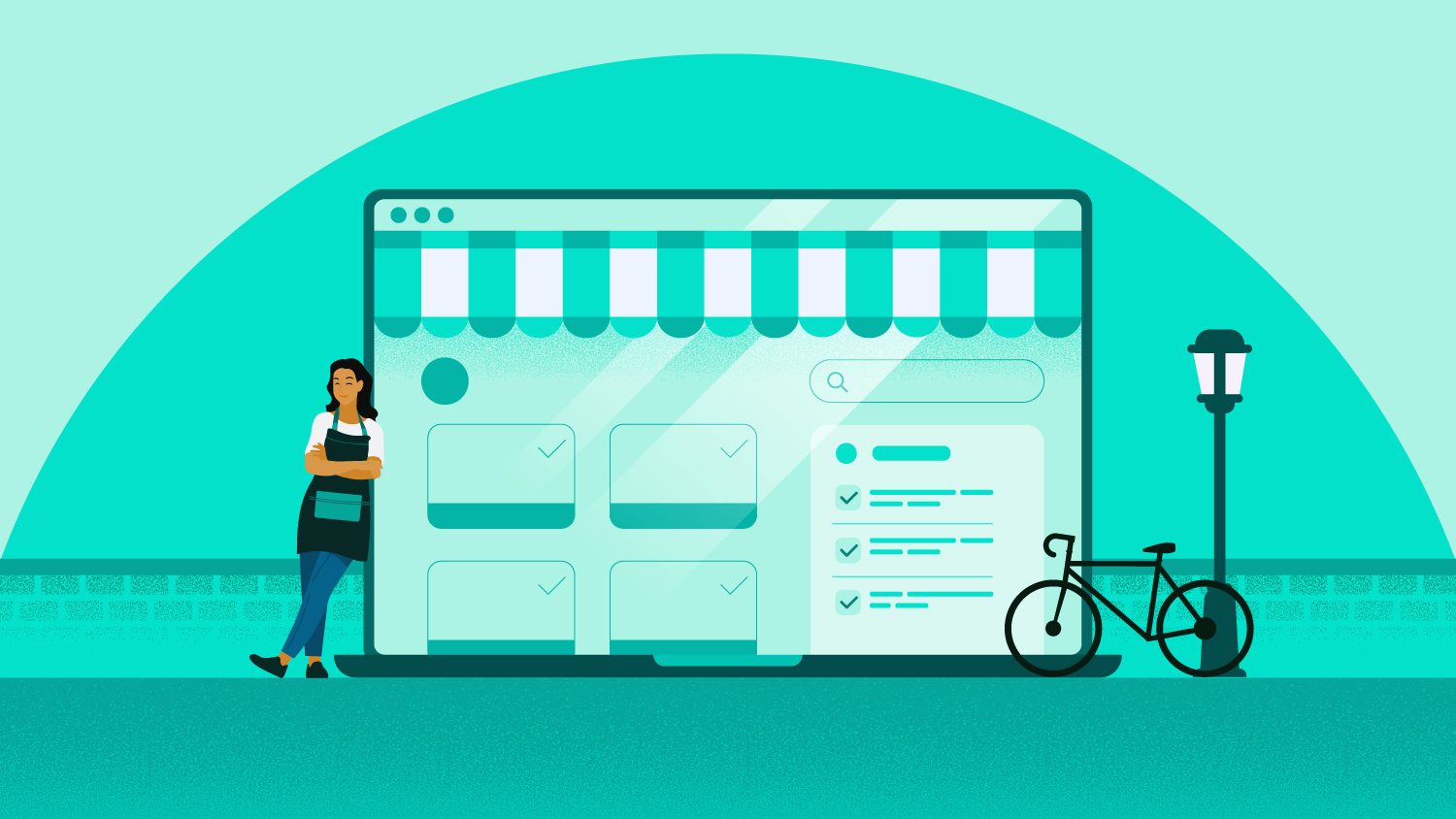Small Business Ecommerce: How to Compete with Big Enterprise

If your SMB is thinking big growth, analyze this data to attract and retain the right customers and make them happy with every click.
The internet is loud — especially for a small or medium-sized business (SMB). And, if you’re a small ecommerce business competing with large enterprises, you’ll face plenty of David vs. Goliath moments. However, there’s space for everyone. Commerce business owners expect online purchases to boost significant revenue increase in the next two years. Our research proves that around 53% of customers prefer to engage digitally. But can small businesses implement a successful ecommerce strategy with limited time, budget, and resources?
The answer is yes — and to help you grow your own digital storefront, we’re sharing some practical tips.
What is ecommerce for small business?
In simple terms, ecommerce is buying and selling products or services online. It includes online retail stores, digital marketplaces, business-to-business (B2B) commerce transactions conducted electronically, and mobile commerce. It allows customers to shop from the comfort of their couch — or while scrolling through social media. Traditional retail businesses can benefit from ecommerce as it helps them enter global markets and reach a wider audience without physical storefronts.
But, here’s the thing: ecommerce world is highly competitive. So, having great products isn’t enough — you also need a solid strategy and consistent ecommerce experiences to meet your business goals.
Five tips that’ll give your ecommerce SMB an edge
The ecommerce market in the U.S. will reach a whopping 333.5 million users by 2029. So, it’s a no-brainer that ecommerce is here to stay. As a small ecommerce business competing with large enterprises, you should rely on the winning trifecta: content, data, and customer experience. These five tips will help you stand out:
1. Use AI to track metrics and get ahead
Although your business plan evolves as you scale, the metrics for your ecommerce success stay the same. Stay on top of these metrics to uncover actionable insights with artificial intelligence (AI). When you understand how your business performs, it’s easier to find opportunities and areas for growth, and to budget for continued success.
Discover where there’s room for improvement and how to adjust your ecommerce strategy:
Sell More With Salesforce For Small Business
- Drive traffic to your website or channel. Determine how shoppers find your site — organic search, paid advertising, or social, using tools like Google Analytics, Meta Business Manager, or your customer relationship management (CRM) tool. Once you know your website traffic, you can focus on getting more. For example, if most people find you through organic search, you can double down on your SEO strategy or supplement it with a paid advertising campaign.
- Know your conversion rate. Conversion rate is the percentage of visitors who purchase a product or fill out a form on your site. It measures how many visitors place an order. Compare this number against the industry average to determine whether your products or services are competitive. Track your conversion rate over time with your CRM to identify trends and act on them quickly. For example, if your conversion rate drops suddenly, there could be an issue with your checkout workflow or site performance.
- Boost your most popular products. To find this out, obtain the average number of units per transaction (UPT) — the average number of products customers purchase in a single transaction. Aim to increase this number by offering discounts or recommending relative items that complement your shopper’s primary purchase.
- Track the total number of successful orders placed. Understanding this number is crucial as it can help you with inventory planning. Particularly when you’re planning for high- and low-demand seasons. You can track the number of orders using an order management system, payment gateway tools, or custom back-end tracking. A CRM tool can be a great choice because you can track everything from one unified place.
2. Create searchable, clickable content on all channels
Google processes over 99,000 search queries every second — that’s over 8.5 billion daily searches. Simply put, people are looking for products and services every hour of the day. To capture their clicks and get buyers in your sales pipeline, create relevant content through the lens of search trends, keywords, and search intent. This can help you attract the right customers to your website and boost conversions.
If you have a limited budget, consider free, open-source tools such as Google Trends and AnswerThePublic to understand emerging keywords and try incorporating them into your content. Review the results regularly and make updates to improve performance.
Did you know that about 49% of internet users in the U.S. prefer buying products from live commerce? As social channels become a larger piece of the ecommerce puzzle, pursue opportunities on Instagram, Facebook, and TikTok. Live commerce — hosting live virtual events with shopping opportunities — blurs the line between entertainment and shopping, and it can be a lucrative channel for your SMB.
Even if your audience size is small, you can use events for audience engagement. They offer multiple opportunities to engage with hot leads in real-time, answer live questions about your products and services, and demonstrate features.
Kickstart your SMB with Starter Suite
Get started with CRM and see results from day one with Starter Suite — the all-in-one suite with the marketing, sales, service, and commerce tools you need to succeed.



3. Simplify product discovery with AI
Driving traffic to your site may not be enough these days — you also need to convert your visitors into customers. Offering seamless shopping experiences by reducing unnecessary steps in your customer’s shopping journey can drive high conversion and revenue.
Create guided selling techniques like assessments or quizzes to encourage product discovery and help customers find what they’re looking for. Engaging and creative content will help your customers visualize your products better. Celebrate customers by featuring user-generated content (UGC) from social media on your site or channels.
AI technologies like Natural Language Processing (NLP), conversational search, and visual search can significantly impact product discovery. As an SMB, manually analyzing data for insights can be time-consuming. AI takes the guesswork out of product recommendations and can automate merchandising. They can predict trends, suggest hyperpersonalized recommendations by understanding user preferences and behavior, and provide real-time personalized support through autonomous agents like Agentforce, customizable and easy-to-deploy AI agents.
Customers indeed appreciate it: 60% are open to the use of AI in customer engagement, including 66% of millennials.
Source: State of the AI Connected Customer, Seventh Edition
4. Streamline your checkout workflow
The customer journey doesn’t end at “add-to-cart” — in fact, the cart is an entire experience in itself. Implement smart cart features through real-time cart updates and a wishlist. Add a quick checkout process, including a one-click checkout process, which auto fills your repeat customers’ information like contact, shipping, and payment details, offering a seamless purchase experience.
Offer a variety of payment methods to contribute to a better customer experience. Enable all major global digital payment methods. Credit cards, and mobile wallets such as Apple Pay, Google Pay, and PayPal will help increase your bottom line. In fact, PayPal converts 28% higher at checkout when compared to other payment methods.
With changing market conditions, consider the best method for getting your products to your customers. A connected in-store and digital inventory order management system can help you offer buy-online-pick-up-in-store (BOPIS) and curbside pickup at your local shop. Customers always appreciate businesses that provide multiple options.
5. Set up a unified commerce solution
Businesses often use multiple disconnected systems for order management, payments, and commerce, which leads to operational inefficiencies. Implementing quick-fix solutions creates fragmented operations, and your team will have to run helter-skelter to offer a smooth customer experience.
But a unified commerce solution can fix this as it offers a 360-degree view of your business. You can build your online storefront using our easy to use and customizable Starter Suite solution. It enables emerging and growing businesses with tools for marketing, sales, productivity, digital storefronts, and customer service. Everything you need to run and grow your ecommerce business comes with built-in guidance. And the best part? You can unify your data and systems and get started on day one.

Going big as a small business ecommerce
Running an ecommerce business today is no easy feat — but watching your idea come to reality is worth the effort. Salesforce Starter Suite offers comprehensive support to ecommerce business. You can customize it as per your business needs. Get started with Starter Suite today. If you’re looking for more customization, explore Pro Suite.
Already a Salesforce customer? Activate Foundations and try out Agentforce.
AI supported the writers and editors who created this article.





























